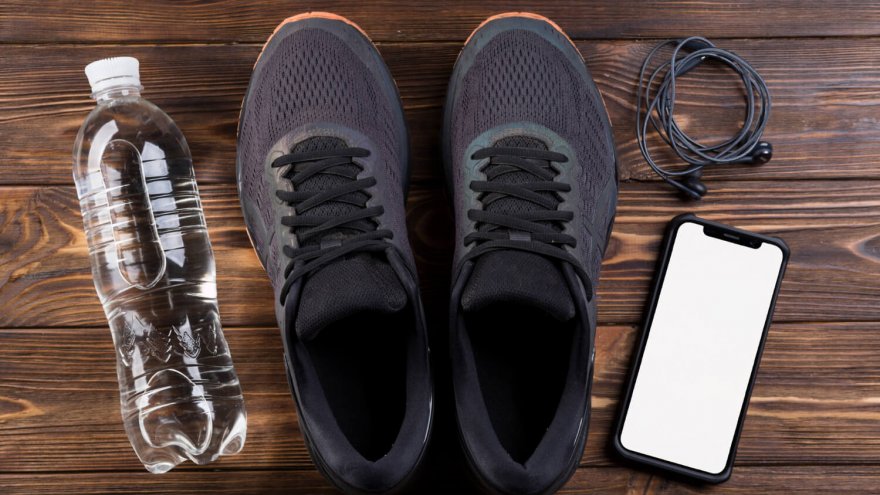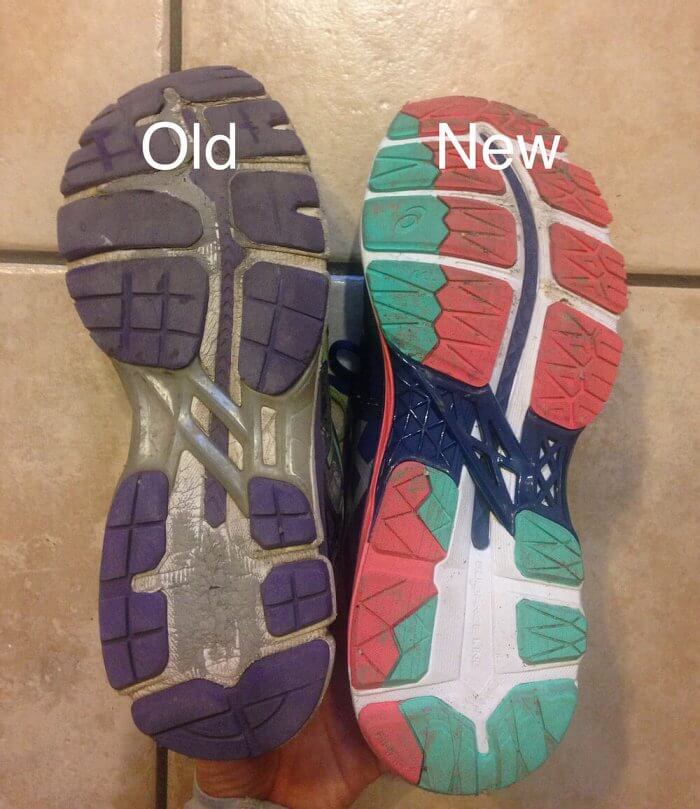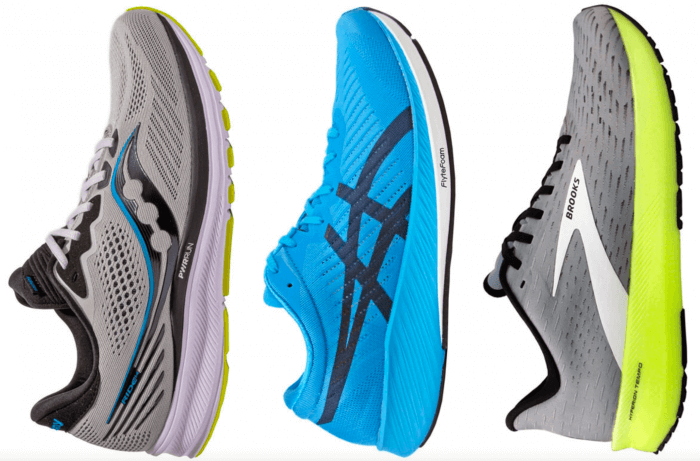5 Tips to Make Your Running Shoes Last Longer

If you are like me, you have a slight obsession with athletic shoes. I have running shoes, walking shoes, cross-training shoes… well… you get the drift.
I track the miles I put on my shoes with vigilance because I know that if I fail to replace them at regular intervals, I will end up with shin splints and other potential problems. Trying to extend running shoe life beyond what it should often end badly.
Do you ever find yourself wondering how long your shoes should last? How can you tell if they are starting to break down? When do you replace them?
You’ve got questions? We have answers!
What Is the Average Life of Running Shoes?
While the life of a pair of running shoes can vary a great deal from one athlete to the next, the majority of people seem to get the same amount of mileage out of a pair of shoes. Running shoes seem to last somewhere from 350 – 500 miles. This can be 3 months or 6 months or a year… depending on how much you run.
If you run about 20 miles per week, this will be about 4 – 6 months of wear for you!
This is a reason why many athletes keep track of the number of miles on running shoes. There are apps where you can track your runs that also allow you to input your shoes. That leaves nothing to chance in regards to how much mileage is left on a pair.
Although I do use fancy technology for my running, I track my shoe mileage the old school way: on a paper calendar. Each pair in my rotation has its own color and after a run, I log the number of miles then highlight it in that specific color.
How Do I Know If My Running Shoes Are Worn Out?
Tread: One big sign that your shoes are worn out is to flip them over. Are the treads on the bottom showing significant wear? This is true whether the entire bottom is showing wear, or if just some portions are. Depending on your foot strike, you will show use in different areas.
Shock Absorption: If you are experiencing poor shock absorption, this is a sign your shoes need replacing. Feeling the impact with every step is not usually a good sign.
Pain When Running: Many athletes are like me in the respect that as their shoes get worn out they start to experience pain. Mine first pops up in my shins. At the first sign of shin pain, I know it’s time to replace shoes. If I am paying attention I don’t let it get that far!
High Mileage Shoes: Runners who track their mileage on shoes often know they need to think about replacing the shoes long before they actually need to. More on that later!
Newer Shoes Feel Better: If you rotate the shoes you wear from one run to the next, you may find that the newer shoes feel much better. Don’t keep wearing a pair that leaves you feeling beat up after a run. That is not worth it!
How Many Miles Do Most Running Shoes Last?
As said before, most shoes are good for anywhere from 350 – 500 miles. Although I have friends who have to replace at 250 miles, as well as pals who get closer to 750 out of a pair of shoes.

Just like every runner’s body is different, so is the amount of use they can get from a pair of shoes. The most important thing you can do is to be aware of your own body and what it needs. Don’t try to push your luck! Not with something as important as your feet!
How Long Can Running Shoes Last in Storage?
If a shoe is stored, they actually have a fairly long shelf life. Now, this is assuming that the pair of shoes is not exposed to elements, sun, UV light, etc. Assuming the shoes are packed away in a box, they can last anywhere from 2 to 3 years.
Some runners test this theory if the shoe they love to wear goes out of production. They rush out and purchase a bunch of pairs before they can no longer get the beloved shoe. I can somewhat relate to this. The danger of this is multifaceted.
First, shoes do have a storage shelf life. Also, why assume that the replacement shoes are not also of great quality? There are some wonderful shoes out there. Branch out!
5 Tips to Make Your Running Shoes Last Longer
In addition to everything else, you can do some very specific things to help your shoes last longer!
- Avoid the washer and dryer: If your shoes need to be washed, try to wash them by hand in a washtub with a gentle brush. Dry them by stuffing them with newspaper. Do not put them in a clothes dryer, nor should you use a boot dryer.
- Conserve your shoes by wearing them only for running: Don’t use them for daily wear or walking. Running shoes should be for running!
- Keep them out of extreme elements: No, I’m not saying don’t run in the heat. However, you also should not leave them in your car out in the hot sun. Shoes should not live in a hot garage either.
- Clean your shoes regularly: But do it gently, as described above.
- Remove the inserts for cleaning and airing out: That will help keep odor down!
The smartest thing you can do is to keep track of how long you have been wearing a pair of shoes. That keeps you aware of when they may need to be replaced.
Rotating Your Running Shoes

One way to lengthen your running shoe life is to rotate between pairs. Shoes with cushion benefit from at least 24 hours to bounce back between wearings. For this reason, it pays to wear a pair every other day. Giving a pair of shoes time to recover between runs helps you reap the full benefit behind the cushion.
Another reason to rotate your shoes is that different shoes serve different purposes. If you are running long, you may want a shoe with more cushion. Shorter runs may be okay with a lighter shoe with less stability. Track and other speed work may warrant a racing flat. Trail runners could certainly benefit from having shoes specific to trail running and other pairs meant for road running.
Although many coaches recommend that you should rotate different kinds of shoes, many people rotate different colors of the same exact brand and style of shoe. Both methods are effective.
You should rotate a minimum of two pairs, but there are athletes who rotate many pairs. As long as you can keep track of the mileage and age of each pair, you have nothing to lose by having choices!
Latest Articles
 Is Running on a Treadmill Easier Than Running Outside?Runners have their own preferences, whether it is treadmill running, running outside on the road, or exploring trails. So...
Is Running on a Treadmill Easier Than Running Outside?Runners have their own preferences, whether it is treadmill running, running outside on the road, or exploring trails. So... Is It OK to Use Trail Running Shoes on the Road?While trail running shoes can be used on roads, especially in situations where a runner encounters mixed terrains or pref...
Is It OK to Use Trail Running Shoes on the Road?While trail running shoes can be used on roads, especially in situations where a runner encounters mixed terrains or pref... How to Fix Sore Quads After Running?Rest, ice, gentle stretching, and over-the-counter pain relievers can help soothe sore quads after running. Also, ensure ...
How to Fix Sore Quads After Running?Rest, ice, gentle stretching, and over-the-counter pain relievers can help soothe sore quads after running. Also, ensure ... 10 Fruits With The Most Electrolytes to Replace Sports DrinksThese fruits are high in electrolytes such as potassium, magnesium, and calcium, essential for hydration, muscle function...
10 Fruits With The Most Electrolytes to Replace Sports DrinksThese fruits are high in electrolytes such as potassium, magnesium, and calcium, essential for hydration, muscle function...

